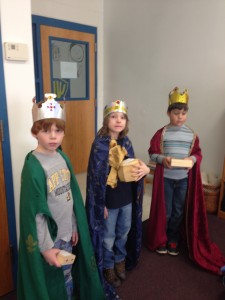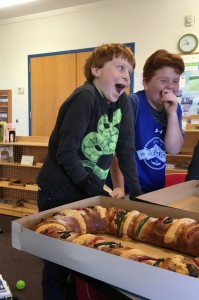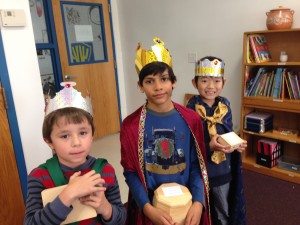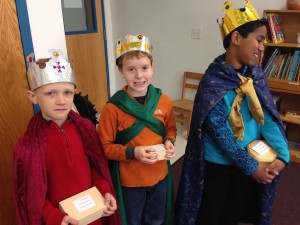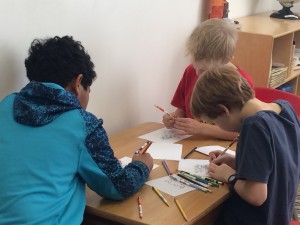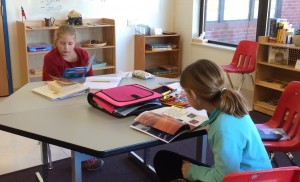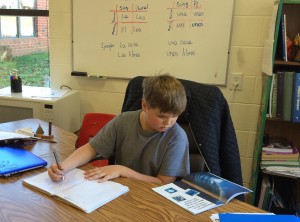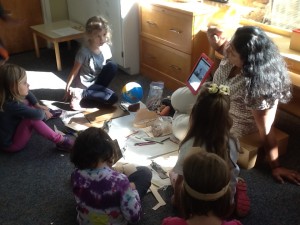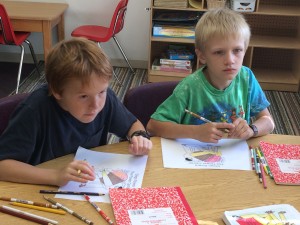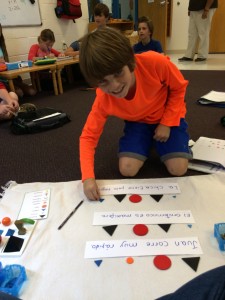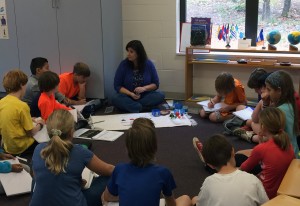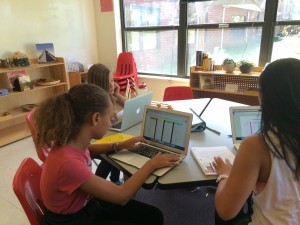Greensboro Montessori School's Upper School students took a leading role in Friday's Earth Day celebration. Upper Elementary students kicked off the morning with readings of original poetry and Spanish. After the program (which we shared live on Facebook), Junior High students hosted Lower and Upper Elementary students at eight different different stations set up on the Athletic Field. Each station featured an activity to to raise awareness for Earth Day, including ideas for recycling, composting, and even limiting our waste. Primary students enjoyed a lesson with our environmental educators, Chelsi Crawford and Sara Stratton. Toddler students took everything in from their shaded mats under the trees, just steps away from their play yards.
The original poetry shared by our Upper Elementary students highlights our integrated curriculum. Students combine their skills in English, Spanish, creative writing, science, environmental education, public speaking, and leadership all at once. We are honored to publish their work for all to experience.
Redbud Tree
Lydia, Sixth Grade
The Eastern redbud tree, purple blossoms in early spring. Small beacons of colour adorn the dull, monochromatic landscape. Bursts that spring is just around the corner.
As the blossoms begin to fade, they get swept away by the gusts of wind that spring brings. Petite purple petals pressed onto the ground as they get trampled by tiny feet. But not all is lost, leaves that are a deep crimson, like garnet, or a sharp, zesty lime the size of a hand unfurl. The leaves are shaped like spades. Desperately trying to hold onto their branches by their paper-thin stems. Through treacherous storms they hold on, not falling yet, for the leaves have roots of their own.
The redbud tree is eternally stretching, reaching its roots through the mycelium and soil, while the branches are competing for the warm rays of sunlight. The uneasy cottontail rests by the roots of the tree, protected by the lush canopy from the hungry hawks’ view.
During autumn, the leaves of the redbud tree glow orange, like a campfire. Only turning into a bonfire as the chorus of the other deciduous trees chime in in the early November. Then, the redbud tree goes to sleep as the long, cold winter days begin.
Día de la Tierra Upper Elementary Group A
- Debemos cuidar la Tierra porque es el único planeta que temenos.
- Debemos cuidar la Tierra porque es nuestra casa y nuestro hogar.
- Debemos cuidar la Tierra porque vivimos en ella.
- Debemos cuidar la Tierra porque hay animales, árboles, océanos y más.
- Debemos cuidar la Tierra porque es la casa para todos los tipos de vidas.
- Debemos cuidar la Tierra porque nos da comida.
- Debemos cuidar la Tierra porque es la casa de todos.
- Debemos cuidar la Tierra porque es muy bonita. Los humanos debemos comprender que no se debe hacer daño a la Tierra.
- Debemos cuidar la Tierra porque o si no nos extinguieremos.
- Debemos cuidar la tierra porque es nuestra protectora y nuestro hogar.
sphagnum
Tanner, Fourth Grade
The sphagnums dance in the rain like an umbrella being twirled. The sphagnums dance in the rain on the mother tree. The sphagnums dance in the rain in the rainforest. The sphagnums dance in the rain under the shade. The sphagnums dance in the rain and the damp mother tree is playing her music. The sphagnums dance in the rain, their spore capsules open up and the spores fly away. The sphagnums dance in the rain as the 10,000 ancestors watch them. The sphagnum dances in the rain, the calm green color is shimmering on as the rain falls on them, the sphagnums dance in the rain; they have no roots, stems, leaves or seeds. The sphagnums dance in the rain, they can grow until they run out of room. The sphagnums dance in the rain in their fuzzy soft coats. The sphagnums dance in the rain. They are used for medicine to save peoples lives. The sphagnums dance in the rain; they get picked and re-planted to make a garden look nicer. The sphagnums dance in the rain.
Greensboro Montessori School's Junior High student council members usually plan three dance parties a year, one each in the fall, winter, and spring. Whether an upcoming dance is your child's first or they have attended these kinds of functions before, we have some details to help you plan ahead.
When: Greensboro Montessori School dances are on a Friday night from 7 to 9:30 p.m.
Where: Dances are hosted in Greensboro Montessori School's Gymnasium
Who: Attendance is limited to currently enrolled students in grades six through nine. In general, students may not bring guests from other schools. In some instances, Greensboro Montessori School has invited other independent schools in the Independent School League to attend dances, but this is the exception to the rule.
Attire: Students may choose to dress up or wear regular clothing. Attire must follow Greensboro Montessori School's dress code. We ask all attendees to wear soft-soled shoes that will not scuff or leave marks on the gym floor.
Chaperones: All dances are chaperoned by faculty and staff from Greensboro Montessori School. On the night of the dance, parents may drop-off their child at the Gymnasium entrance at 7 p.m. and return at 9:30 p.m. when the dance is over. The School always provides the name and cell phone number of at least one chaperone in a personal email to parents.
Cell phones: Students are permitted to bring cell phones to dances.
Entrance Fee: Students pay $5 cash at the door to attend dances.
Music: All Greensboro Montessori School dances have a DJ who is a current student. They develop a playlist based on student requests and submit this playlist for review by their faculty advisor. The faculty advisor reviews the list for content and language and approves only those songs which are age appropriate.
Dr. Maria Montessori was a big fan of field trips. In her words, it was important for students to take “outings” or to “go out.” In 1948, Dr. Montessori wrote: “The outing whose aim is neither purely that of personal hygiene nor that of a practical order, but which makes an experience live, will make the child conscious of realities … When the child goes out, it is the world itself that offers itself to him. Let us take the child out to show him real things instead of making objects which represent ideas and closing them up in cupboards.” Hence, the Montessori phrase of “going out” was born.
At Greensboro Montessori School, we take the Montessori tradition of “going out” to heart, as our students take academically aligned, overnight field trips beginning in Lower Elementary. Where lessons in the classroom are a springboard to learning, Montessori outings provide the experiences necessary to move concepts from the abstract to the concrete – to let students apply and expand their knowledge in the world around them.
As our students progress from Toddler to Junior High, they learn the rites of passage, including the field trips, which will greet them along the way. Read about all our adventures, or jump to the grade which interests you most!
Lower Elementary
Second Grade: Students enjoy their first overnight outing in second grade. This year, our second graders will spend a night at The Land, our 37-acre satellite campus in Oak Ridge. This wooded retreat includes a 14-bedroom retreat center, a barn, a covered bridge spanning a freshwater stream, mature hardwoods, peaceful trails, privacy and seclusion, and diverse flora and fauna.
Third Grade: Third graders take annual trips to either Earthshine Discovery Center in the Nantahala National Forest in western North Carolina or the Sound to Sea program along the North Carolina’s Crystal Coast. Students spend two days and three nights building upon their lessons in biology, botany, environmental studies, geography, and physical science.
Upper Elementary
Fourth and Fifth Grade: Fourth and fifth graders rotate between annual field trips to North Carolina’s Outer Banks and Colonial Williamsburg every spring. When at the North Carolina coast, our students experience the region’s rich marine biology and storied history. Students visit national landmarks like Roanoke Island, the first settlement of English colonists, and the Wright Brothers National Memorial in Kitty Hawk. In the words of the National Parks Service, Kitty Hawk is the site where Wilbur and Orville Wright “experimented with flight in the early 1900s, and finally succeed[ed] on a cold winter day with the world's first controlled, sustained, powered, heavier-than-air flight.”
When visiting Williamsburg, students immerse themselves in the history of the American Revolution and explore, as Colonial Williamsburg puts it, “the political, cultural, and educational center of what was then the largest, most populous, and most influential of the American colonies. It was here that the fundamental concepts of our republic — responsible leadership, a sense of public service, self-government, and individual liberty — were nurtured under the leadership of patriots such as George Washington, Thomas Jefferson, George Mason, and Peyton Randolph.”
Sixth Grade: Sixth-grade students head to our nation’s capital, where they visit multiple Smithsonian museums, (including the National Museum of African American History and Culture and the National Air and Space Museum), the National Archives, Arlington National Cemetery, and the National Gallery of Art and Sculpture Garden. Students expand upon their knowledge of national government and civics, while practicing grace and courtesy in a metropolitan city center. Dr. Montessori writes: “A child enclosed within limits however vast remains incapable of realizing his full value and will not succeed in adapting himself to the outer world. For him to progress rapidly, his practical and social lives must be intimately blended with his cultural environment.”
Junior High
Seventh Grade: Greensboro Montessori School’s seventh graders head west to Tuscon, Arizona, where their years of environmental science studies take center stage in this week-long trip. In addition to hiking Kitt Peak, students spend time at the University of Arizona’s Biosphere 2, a state-of-the-art scientific facility. The mission of Biosphere 2 “is to serve as a center for research, outreach, teaching and life-long learning about Earth, its living systems, and its place in the universe; to catalyze interdisciplinary thinking and understanding about Earth and its future; to be an adaptive tool for Earth education and outreach to industry, government, and the public; and to distill issues related to Earth systems planning and management for use by policymakers, students and the public.”
Eighth Grade: Greensboro Montessori School’s eighth graders enjoy an authentic immersion experience in Costa Rica. Our students stay with the Costa Rican families of students from The Summit School, our sister school in Coronado, Costa Rica which is very close to the capital city of San José. Together, our students and the Ticos (a colloquial term for natives of Costa Rica) go everywhere together. They visit volcanoes, complete high ropes courses, and sail through the rainforest canopy on zip lines. They travel to the Caribbean Coast where they walk the beach at night looking for turtle eggs to bury in a nearby protected hatchery. Then, they travel to the Pacific side to snorkel and explore rain forests and animal sanctuaries. They also spend a day in downtown San José learning about Costa Rican history, art, and government. With every visit to Costa Rica, our students return with their eyes a little wider and their lives a little richer as they have their first experience actually living in another culture.
Ninth Grade: An important element of our ninth-grade curriculum is the completion of a year-long capstone project that challenges each student to apply their skills to an area of personal interest that will improve and enhance their world. Similar to a thesis or senior project, the capstone project provides a framework for demonstrating leadership and advanced application of critical thinking skills. To further extend their learning, the students are challenged to design a custom end-of-year outing to include research opportunities for each of their individual capstone projects. In collaboration with a faculty advisor, a past ninth grade class settled on an itinerary traveling throughout the Pacific Northwest. Their route took them to explore tidal pools, tour museums in Seattle, visit a military base in Tacoma, and interview refugees in Vancouver.
In 2005, Greensboro Montessori School eighth graders first traveled to Costa Rica for a cultural immersion experience. We were eager to connect with another Montessori school abroad with a similar adolescent program. Our research led us to The Summit School in Coronado, Costa Rica which is very close to the capital city of San José. On our first expedition to Costa Rica, we incorporated a formal school visit to The Summit School and it was the highlight of our trip. The parents made a special lunch for us, and our students assisted the younger Costa Rican children with a school project. When we returned the following year, students from The Summit School accompanied our students in our daily travels and service learning adventures. At that point, Greensboro Montessori School and The Summit School became sister schools.
Since then, the eighth grade trip to Costa Rica has morphed into an authentic immersion experience. Our students stay with the Costa Rican families of The Summit School students, and together, our students and the Ticos (a colloquial term for natives of Costa Rica) go everywhere together. We visit volcanoes, complete high ropes courses and sail through the rainforest canopy on zip lines. We travel to the Caribbean Coast where we walk the beach at night looking for turtle eggs to bury in a nearby protected hatchery. We travel to the Pacific side to snorkel and explore rain forests and animal sanctuaries. We spend a day in downtown San José learning about Costa Rican history, art, and government. Our weekends are spent with the host families doing what they usually do. The students also do things you would expect them to do on the weekends: they get together and go to the mall or a movie or a party at someone’s home.
Every year, when asked what our students’ favorite part of the trip is, they always say their homestay with the Tico families. Our students make friendships that last for years, and some even return to Costa Rica on their own to visit their “families.”
In 2009, the Ticos first ventured to Greensboro Montessori School to stay with our students and learn more about North Carolina. Even though we don’t have erupting volcanoes or zip lines through the rain forest, we still have a great time sharing the landmarks and natural wonders of our state with them. Our visits have included such destinations as the Duke Lemur Center, the North Carolina Museum of History, and Hanging Rock State Park. On a recent visit, our itinerary included kayaking on the Dan River, exploring Grandfather Mountain, and a tour of the Duke University Marine Lab in Beaufort. Our homestay hosts always arrange social gatherings for the students on the weekends. The Ticos typically experience some classroom time with us as well as a trip to The Land in Oak Ridge.
Our students benefit tremendously from the life-changing experiences resulting from our relationship with The Summit School. With every visit to Costa Rica, our students return with their eyes a little wider and their lives a little richer as they have their first experience actually living in another culture. They begin to see the world in a different light and develop a new appreciation for the abundance in their lives.
“I fell in love with teaching again when I came to GMS."
The 2016-17 school year marks Sandra Lee’s fourteenth year of teaching Spanish at Greensboro Montessori School. For seven of those years she has been leading our 8th graders on their capstone experience end-of-year field trip to Costa Rica where they engage in a tremendous cultural exchange program with our sister school, the Summit Montessori School in San José. Through Sandra's stewardship, our Middle School students benefit from the unique opportunity to experience life immersed in a different culture, testing not only their language abilities but their capacity for adaptation, selflessness and citizenship.
While in Costa Rica, our students are paired with a host family and develop friendships with the middle school students at Summit Montessori School. Those formative relationships make lasting impressions on our students and help give them a deeper perspective of their role and responsibility as a global citizen. Sandra says, “What I love most about this program is that our students get to experience a very different reality and way of life when they are there. Plus, learning language has a lot to do with necessity, and while our students are in Costa Rica they may be staying with a host family that has very limited English. In those situations, their Spanish is essential.”
Sandra has taught students of all ages at Greensboro Montessori School. When she first started teaching to GMS in 2003, she taught Spanish in the Primary program. “I have never been more creative than when I taught at the Primary level because for children at that age, you have to be ready to adapt your lesson in a moment’s notice.” After a few years in Primary, she moved up to teach Spanish in Lower Elementary and then Upper Elementary. Now she is a leader and mentor for our team of Spanish faculty, including Susana D’Ruiz and Rossana Aranda, and thoroughly enjoys collaborating with her other colleagues while teaching in Upper Elementary and Middle School.
“One of the reasons I have loved working with Middle School is because of the strong relationships we end up having with our alumni. My former students often come back and tell me how much they are using what they learned in my classes. I know many GMS alumni who took Spanish 4 or Spanish 5 classes while they were in high school and their fluency is amazing."
Regarding the Spanish curriculum at GMS, Sandra says “since there is no specialized Montessori training for Spanish language teachers, over the years I have developed a hybrid Spanish curriculum that incorporates Montessori lessons together with more traditional teaching methods. I weave together web-based learning through a customizable web program called Conjugemos, textbook learning through Realidades (a traditional source also used in Guilford County Schools), and coordinated lessons with my Montessori colleagues. For instance, in Upper Elementary I work in tandem with the lead teachers to present Spanish lessons in geography and grammar right after the students have had the same lesson in English. It creates a greater context for their learning and makes it more relevant for the kids.”
Sandra holds a bachelor’s degree in English education from Universidad de Talca, Chile and always knew that she wanted to be a foreign language teacher. It is a funny coincidence that instead of teaching English to her fellow Chileans, now she helps the students of GMS immerse themselves in the language and culture of her home. But Sandra wasn’t always a Spanish language teacher. When she first moved to the United States in 1985, she worked as a technical translator and senior editor for AT&T and Lucent Technologies. How did she find GMS? Well, soon after her oldest daughter Isabella was born, Sandra began to explore preschool programs and landed at GMS at the recommendation of her extended family members whose children were already enrolled. Isabella enrolled in our Toddler program in 1998 and that was the beginning of Sandra’s journey with GMS. “I fell in love with teaching when I came to GMS,” says Sandra.
In a recent interview Sandra described GMS as a place that feels just like home. “The kids and my colleagues make me feel so good about myself and my work. The school has been a tremendous emotional support for me over the years and I really love teaching here. Everywhere I go in Greensboro, I see someone I know from my GMS family.”
January was a busy month in our Spanish classes, but we also had time to learn about Día de Reyes (Three Kings Day), a Spanish tradition celebrated on January 6 (the 12th day of Christmas) that commemorates the story of the three wise men who traveled from afar bearing gifts for the newborn Jesus. Hispanic children often set out symbolic goodies for the Kings and hay to feed their camels as well as a place to leave their shoes. When morning arrives, children discover that the camels ate the hay, and there are wrapped presents waiting beside their shoes.
Did de Reyes observance comes to a close with another Spanish Christmas tradition: a typical breakfast of Roscón de Reyes, a ring-shaped cake decorated with fruits symbolizing the precious gems that adorned Los Reyes Magos' clothing.
Our kids observed this tradition by sampling the Roscón de Reyes.
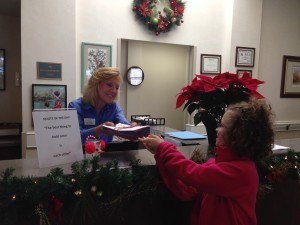
Willa delivering the Holiday cards to Well Spring Retirement Community made by Lower El students
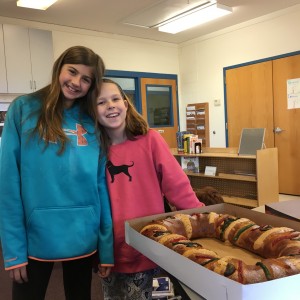
Bella and Lola ready for the Rosca
Greensboro Montessori School Elementary Spanish lessons practice vocabulary for shopping "en el mercado."
In Spanish classes, the highlight of this month was the end of the year holidays. The students learned about celebrations around the world and their influence on Latin-America.
Primary
by Yeny Hernandez [dt_sc_email emailid="[email protected]"/]
The excitement of the end of the year celebrations was present in the Primary classes. In Spanish, we discussed the different celebrations around the world which have the common theme of light. Apart from talking, drawing and singing, the kids worked with lights related vocabulary like Luz (light), estrella (star), luna (moon), and sol (sun).
Lower Elementary
by Susana D'Ruiz [dt_sc_email emailid="[email protected]"/]
In our lessons on the end of year holidays, we covered Fiestas Alrededor del Mundo (Festivities Around the World) most of which use lights symbolically in their celebrations. One of the activies we did to commemorate the holidays was to make different celebration cards to be delivered to Well Spring Residence. The students wrote them in Spanish and English.
Upper Elementary
by Susana D'Ruiz and Sandra O. Lee
Fourth Level
This month, the 4th level students have been busy working on parts of speech, vocabulary and phonetics. Our goal is to start working on sentence analysis in Spanish as soon as we return from Winter Break.
Fifth Level
The main contents in 5th level were Geography in Spanish, where the students learned about Central and South American countries, their capitals and borders, and reading comprehension and the use of the dictionary. The kids read "Nuestra Tierra" (Our Earth), and had to write questions and definitions related to the book.
Middle School
by Sandra O. Lee [dt_sc_email emailid="[email protected]"/]
This is a busy time of year for middle schoolers with several projects coming to fruition. Along with this, we maintained our daily focus on Spanish language and academics. The students continued working on the Realidades Program, and their customized review packages. They also had the opportunity to talk about and review the world lights celebrations and listen to Villancicos (traditional Christmas songs in Spanish).
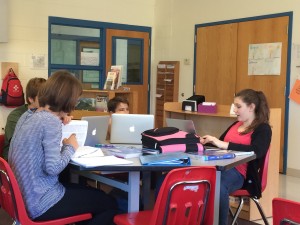
This month, in which Latin America remembers the “Encounter of Two Worlds”, the students were busy in the classrooms learning, working, researching and presenting their work about our rich Hispanic culture and its people. Below is a glimpse of our activities.
Primary
by Yeny Hernandez [dt_sc_email emailid="[email protected]"/]
This has been an active month in Primary in Spanish. The students worked with geometry, recognizing the different geometrical shapes and naming them as they created figures with them.
We also celebrated the Hispanic Heritage Month, talking about different aspects of it: history, geography and art among others.
We look forward to another month of exciting activities!
Lower Elementary
by Susana D'Ruiz [dt_sc_email emailid="[email protected]"/]
In cultural studies, we covered Mes de la Herencia Hispana (National Hispanic Month), songs and cultural content. As an end to cultural month, we read about one of the most renowned Mexican artists, Diego Rivera. In phonetics, the emphasis was on /m/ sound and syllable formation for first level students, and /d/ sounds and syllable formation for second and third levels.
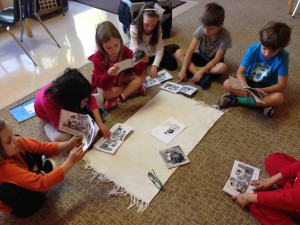
Students working on their phonetics books
Upper Elementary
by Susana D'Ruiz and Sandra O. Lee
Fourth Level
The fourth level students have transitioned well into Upper El. This past week the lessons focused on noun gender. In vocabulary the emphasis was on useful phrases for the Spanish class.
Fifth Level
This month the students have been busy working on vocabulary and sentence analysis. They compared the Spanish versus the English patterns using the Montessori Grammar Symbols. They continue working on vocabulary and phonetics.
Middle School
by Sandra O. Lee [dt_sc_email emailid="[email protected]"/]
Part of October has been marked for the visit of our friends from our sister school in Costa Rica. Our kids had the opportunity to make new friends, practice Spanish and get ready for their trip to Costa Rica in May. But we do not forget about academics during "Mes de la Hispanidad" in which we celebrate the "Encounter of Two Worlds". The students in Middle School researched and presented their work about different people, natural wonders and monuments from Spain and Latin America.
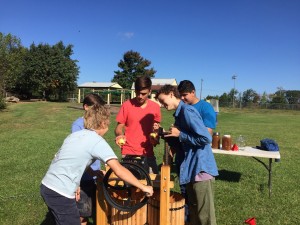
Middle schoolers working with some of our new friends who visited from Costa Rica.
From September 15th to October 15th is the National Hispanic Heritage Month. As part of this celebration in our classrooms, the students will be working on different activities related to Latin American countries and Spain, their culture, artists and landmarks.
Primary [dt_sc_email emailid="[email protected]"/]
We started the month reviewing greetings and learning the Buenos Días song. The students have enthusiastically practiced the song, as well as greetings, colors and numbers inside and outside the classroom. When we finish our lessons, we also sing the "Roll, roll, roll your mat" song in Spanish - "Enrolla, enrolla, enrolla tu alfombra."
During this month, we will be learning and practicing colors in Spanish through the painting “The Flower Carrier” by the Mexican artist, Diego Rivera.
Lower Elementary[dt_sc_email emailid="[email protected]"/]
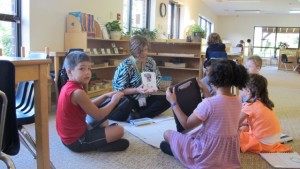
Susana working with small groups in Lower Elementary
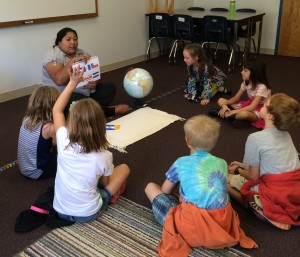
This month, Yeny, a native from El Salvador, will be talking with the Lower El students about her country and its culture.
A, B, C, Ch, D, E, F, .... Gee what a lot of fun we had these past weeks. Our names have been very important this week. We are looking for letters that are the same in each other’s names, counting letters, comparing the length as well as looking for letters that we have learned. We also reviewed greetings in Spanish and vowel sounds. In addition, the students are working on a tongue-twister in Spanish: El hipopótamo Hipo.
Upper Elementary
by Sandra O. Lee and Susana D'Ruiz
Fourth Level
We used the first weeks of school helping students to get to know one another and become comfortable with various classroom routines. One of our goals is to help students become independent workers, so students are currently learning how to organize work in their Spanish notebook, folder and on index cards.
Fifth Level
This month we started our writer’s workshop. The students are very excited, working on constructing and connecting sentences with the final goal of writing paragraphs in Spanish. To do this, they are working on vocabulary lists, spelling exercises and analyzing sentences. Looking forward to share their writing with you!
Middle School [dt_sc_email emailid="[email protected]"/]
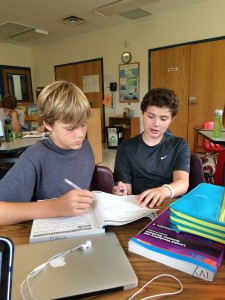
Alex explains to Robbie how to use the Spanish textbook
September has been a busy month in Spanish. Sixth level students have transitioned well. They are getting familiar with the different components of the Spanish 1 program, and I must add they are doing a great job!!!
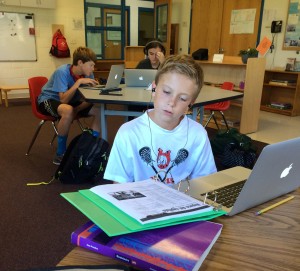
Evan listens and practices vocabulary
Seventh and Eighth levels are working on their projects and presentations about a Hispanic – American landmark or people. The projects will be presented the last week of September. I look forward to see the result of their research work!



